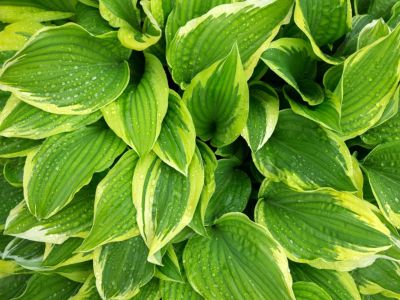Hosta Particulars
Hostas range from the largest at 4 feet (1.2 m.)to the tiniest at only a couple inches (5 cm.). Most Southern Hostas grow in a clump from 1½ to 2 feet tall and wide (.5 to .6 m.). The long-lived perennials, hardy to USDA zones 3 to 9, can be blue, yellow, green or variegated with long, sword-shaped or heart-shaped leaves, sometimes accented with wavy edges or a puckered texture. Southeast Hostas also are grown for their single or double flower spikes in purple, lavender, or white. Some varieties are sweetly fragrant.
Some Like it Warm
Hostas for the South need to be chosen carefully because not all Hostas thrive in year-round warmth and they generally prefer a cold winter. Two of the best species of Hosta in the South are plaintain lily (Hosta plantaginea), which is the most heat and sun tolerant, and Fortune’s plaintain lily (H. fortunei), which can tolerate ¾ and ½ day of sun, respectively. Plant them in moist, well-draining soil amended with compost. Feed lightly with 10-10-10 fertilizer in the spring.
Southeast Hostas: Choosing Hosta Varieties for the South
Here are popular Hosta varieties for the South:
Albomarginata – green leaves with a creamy borderAphrodite – fragrant, double flowered, deep green leavesAugust Moon – heavily crinkled, gold leavesAureoMarginata – deep green leaves with a gold edgeElegans – puckered, blue-gray leavesFragrant Bouquet – apple green leaves edged in yellow or creamFrancee – wide, dark green leaves with a narrow, white marginGold Standard – heart-shaped, chartreuse leaves with a deep green irregular marginGuacamole – variegated foliageHalcyon – heart-shaped, powder blue leavesHyacinthina – large heart-shaped leaves with a blue cast Miss Saigon – variegated foliageMoonlight – variant of ‘Gold Standard’ with a creamy-white edge Patriot – dark green leaves with a white margin Royal Standard – glossy, deeply veined green leaves, fragrantStained Glass – golden leaves with deep green marginsSum & Substance – large, glossy, chartreuse leaves
Pests and Disease
The Hosta is generally pest and disease resistant, however, its chief tormentors are slugs and snails who chew holes in the leaves. Saucers of beer placed even with the soil line are a popular deterrent. Snails are attracted to the beer, fall in and drown. Diatomaceous earth is a powder that can be sprinkled around the plants. Slugs can’t tolerate the sharp edges.
